| Home |
| The Cork-Cutter: Trade Cards and Bills |
Previous: The Cork-Cutter’s Trade
Trade cards and bills give an interesting record of the cork-cutter’s business.
|
Trade Card for the London cork-cutting shop of
Ralph Hassall, showing a sign of three brushes. | |
 |
Ralph Hassall, Cork-Cutter,
at the Three Brushes and Half-moon over against Red Lion Court, in Watling Street, makes and sells all sorts of Corks, at reasonable rates, Wholesale or Retail. date: 1730–1765 from Museum of London collections online  . .
|
|
Bill-head from the Duke of Bedford’s household bills dated London, 1760
| |
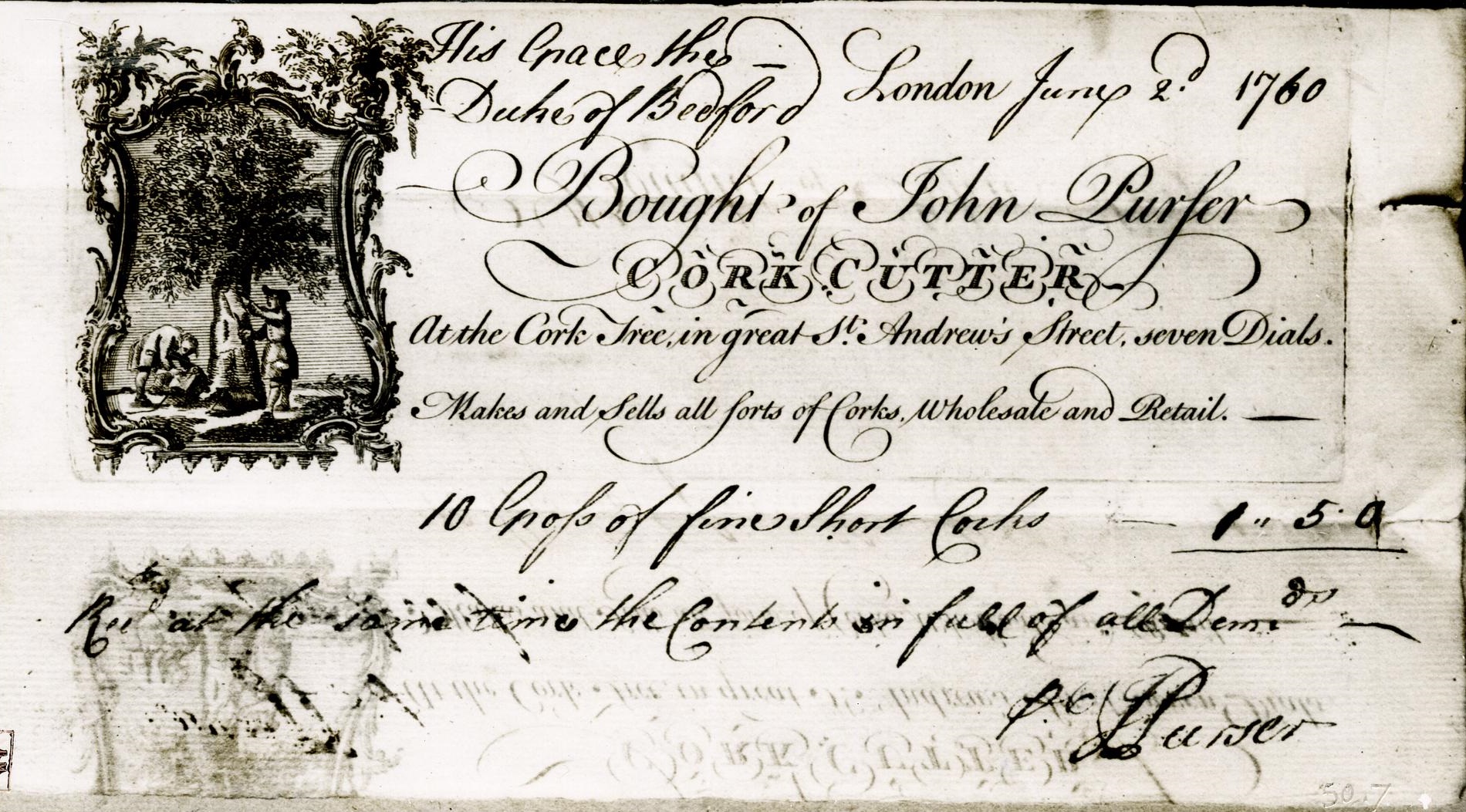 | |
from
Heal Collection,
British Museum  . .
|
The bill-head noted that the London shop, located at Great St Andrew’s Street in the St Giles district near St Giles-in-the-Fields Church, displayed a sign with a picture of a cork tree. The upper left of the bill-head has a print of a cork tree showing two workers stripping and collecting the bark.
The bill was delivered to ‘His Grace the Duke of Bedford’ who, at the time, was John Russell (1710–1771), the 4th Duke of Bedford. His palatial London home, Bedford House, was situated at the northern end of St Giles (now part of Bloomsbury) (1).
In December 1730, when Joseph Purser married the widow Mary Bragg, the marriage register recorded that the bridegroom was a cork-cutter of St Martin-in-the-Fields, London (2). Joseph Purser, who based his business as a cork-cutter at St Andrew’s Street, was buried on 9 December 1755 at St Giles-in-the-Fields Church. In his will he expressed the desire that his nephew John Purser, the son of his brother Edward Purser, should take charge of his company (3). The paper bill, in the collections of the British Museum, prepared by John Purser in 1760, suggests that he was a capable successor to his uncle.
John Purser’s bride Catherine was the daughter of Henry Seale, a merchant of Mark Lane in the City of London (4). They were married on 19 August 1756 at St Olave’s Church, Hart Street.
John Purser’s cousin Joseph Purser, also a nephew of the cork-cutter Joseph Purser, was in the cork-cutter trade in St Anne’s Soho, neighbouring St Giles (5).
From his shop in St Giles, John Purser continued to provide cork-cutter services until his death in 1783. He was buried in the crypt of St Olave’s Church, Hart Street, the burial place of the Seale family of his wife, who survived him. In his will he gave his son John Purser, aged 23 at the time of probate, ‘my trade or business of a cork-cutter to be carried on by him at my decease for his own benefit’ (6).
In 1787 the Sun Fire Office issued a fire insurance policy to John Purser, operating as a cork-cutter at 6 Great St Andrew’s Street, Seven Dials. By 1791 he appears to have closed the business. In this year he purchased a fire insurance policy for a residence at 9 Grange Court, Carey Street, and his property at Great St Andrew’s Street, the legacy from his father, was leased to the engravers Jones and Co. In a fire insurance record for 1811, the home of John Purser was now 23 Prospect Place, Dog and Duck Road (later renamed St Georges Road) in Southwark, near the Elephant and Castle, and his tenant at 6 Great St Andrew’s Street was a ‘coach harness maker’ (7).
Mary Woodmam was a supplier of cork-cutter products on St Giles High Street, in the same neighbourhood as the Great St Andrew’s Street business of John Purser.
Receipt dated 1769
| |
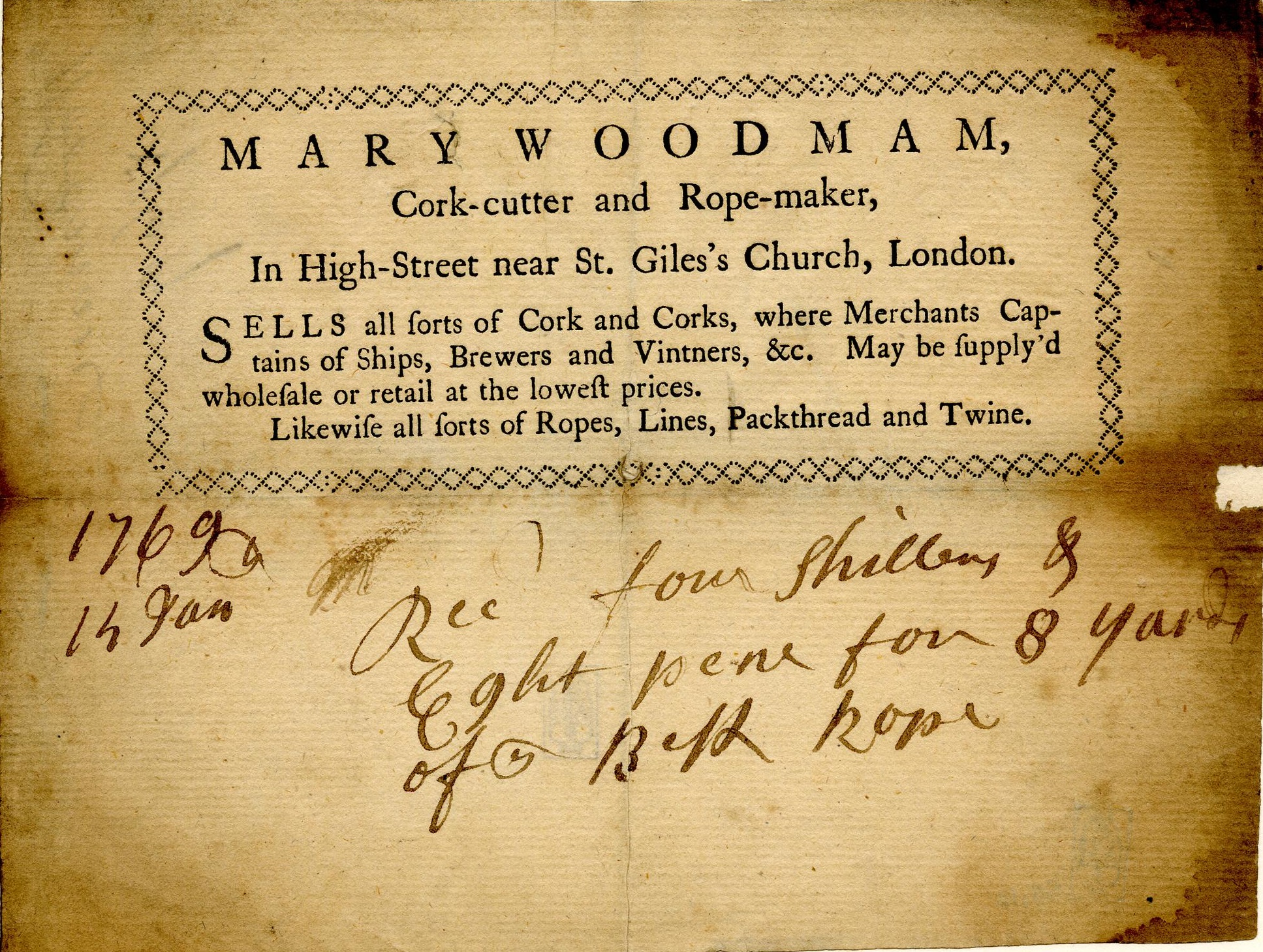 | |
from
Heal Collection,
British Museum  . .
|
Mary Woodmam’s father, Samuel Clarke, was established as a cork-cutter on High Street, near St Giles-in-the-Fields Church, London, where he was buried on 21 November 1751. The joint executors of his will were named as Mary and her husband William Woodmam (in the will, a copy of the original will transcribed by a clerk, the spelling Woodman was used) (8). William Woodman and Mary Clarke were married on 28 August 1744 at St George’s Chapel, Mayfair (9). Possibly they took over the running of the cork-cutter business after the death of Samuel Clarke. At the time of the bill receipt, shown above, Mary may have been in business as a widow (10).
Kent’s London Directory for 1803 had an entry for M. Roberts, ‘Rope Maker & Cork Cutter’, 20 High Street, St Giles’s (11). Possibly this was the business previously carried on by Mary Woodmam.
| Trade Card for
John Lyde & Co, opposite Charles Court, Strand, London. |
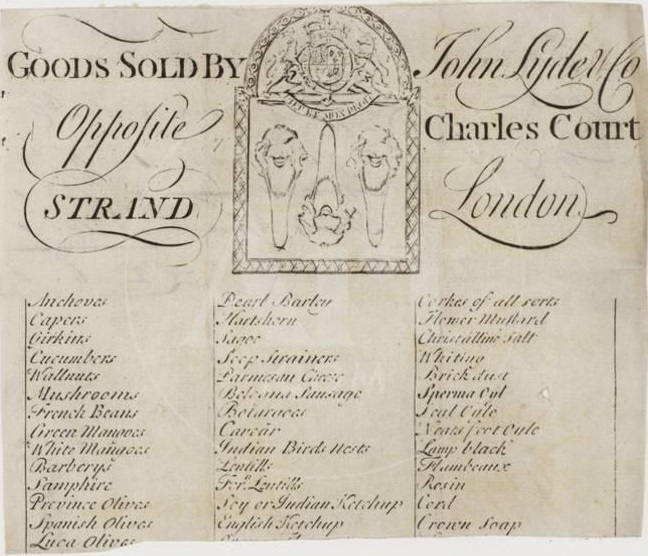 |
Look and
Learn  / Peter Jackson Collection. / Peter Jackson Collection.
|
John Lyde and Benjamin Page, oilmen, 459 Strand, were named in Lowndes’s London Directory for the year 1786 (12). Their trade as oilmen involved running a business as a specialty grocer dealing with edible oils, food preserved in oil, and oil-based products such as soap. Their trade card gave a three column list of items in stock including ‘Corkes of all sorts’ (13). This suggests that one of the suppliers to the oilman’s retail business was a cork-cutter who provided the cork stoppers for the bottles and jars used to dispense the oilman’s products.
The Royal Arms appear to be displayed at the top center of the trade card to suggest the possibility that the firm had a Royal Warrant to act as a supplier to members of the royal family. The shop of Lyde & Co was located at the western end of the Strand facing Charles Court – a convenient location for royal customers. Charing Cross railway station now occupies the old site of Charles Court (14).
The business partnership of John Lyde & Co at 459 Strand was dissolved in 1824 (15).
In the shoe trade, the use of cork for making pattens, a clog that could be used as a protective overshoe, was advertised in the trade card of Thomas Berry of Fleet Street, London. The patten-maker’s craft catered to ladies who wore pattens with a thick sole (depicted on the trade card) to raise and protect their shoes and fine dresses from the mud and grime of London streets. The industrial revolution stimulated projects for the building of better roads and, by the end of the 19th century, the demand for pattens died out (16). The patten-maker’s skills, like the cork-cutter’s skills, became a lost trade.
|
Trade Card for Thomas Berry of London, seller of ‘fine leather cloggs’ . | |
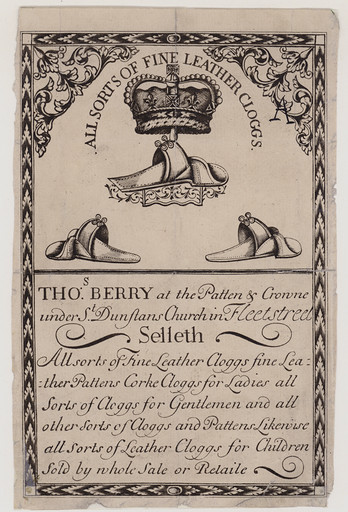 |
Thomas Berry
at the Patten & Crowne under St Dunstans Church in Fleet Street. Advertises: ‘Corke Cloggs for Ladies’. eighteenth century Look and Learn  / /
Peter Jackson Collection. |
On 23 November 1704 Thomas Berry, ‘a patten-maker by St Dunstans Church’, was married to Mary Osborne at St Bride’s Church, Fleet Street. ‘St Dunstans Church’ was the church of St Dunstan-in-the-West situated on the north side of the west end of Fleet Street, opposite Hoare’s Bank, which moved to the location in 1690.
The record of baptisms and burials entered in the parish register of St Dunstan-in-the-West reveals that of nine children born to Thomas and Mary Berry, five died in infancy. The family home was at Hen and Chicken Court (still marked on London street maps), a passage leading off Fleet Street, on the east side of the church of St Dunstan-in-the-West.
Apprenticeship books, kept for taxation purposes, document that Thomas Berry, a master patten-maker, took on a new apprentice in 1711 (17).
A trade card for Robert Rowley, cork-cutter of Newcastle upon Tyne, has a picture that shows a worker stripping the outer bark from a cork tree. Robert Rowley was active in the nineteenth century – baptisms of children of Robert Rowley ‘cork cutter’ and his wife Catherine were recorded in the parish register of All Saints’ Church, Newcastle upon Tyne, in the years 1824 to 1833 (18).
 |
|
Trade Card for Robert Rowley, Cork Cutter,
of Newcastle upon Tyne; 19th century. Advertises: ‘Cork Jackets on the best Principle’. Look and Learn  / Valerie Jackson Harris Collection. / Valerie Jackson Harris Collection.
|
The 1854 Post Office Directory of Berkshire
had an entry for John Dunn, ‘cork cutter,
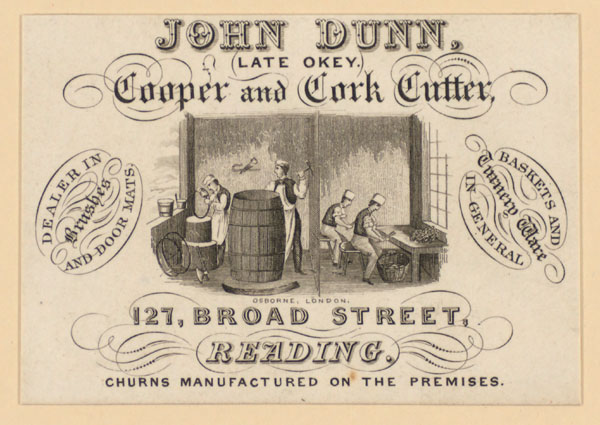 |
|
Trade Card for John Dunn (late Okey), Cooper and Cork Cutter,
127 Broad Street, Reading. Dealer in Brushes and Door Mats; Baskets and Tannery Ware in General; Churns manufactured on the premises. engraved by Osborne of London. from John Johnson Collection of Printed Ephemera  , ,
Bodleian Libraries, University of Oxford. |
To give some more story behind this trade card: John Okey, the previous owner of the business, passed away in early 1845 (20). A notice printed in the Reading Mercury on 8 March 1845 gave assurances that the business would continue to operate to a high standard under the direction of his widow Mary Ann Okey: (21)
|
Mary Ann Okey
(Widow and executrix of the late John Okey) Cork Cutter, Cooper, &c. 127 Broad Street, Reading, |
|
Begs to acquaint the Nobility, Gentry, and others,
customers of her late lamented Husband, that she intends carrying on the Business in all its Branches as heretofore, and respectfully solicits a continuance of that patronage and support conferred on her late Husband for Thirty Years. The Manufacturing Department shall be attended to by efficient workmen, in the hope to give general satisfaction; and, as usual, a competent Brewer will be at all times ready at a few days notice to wait on Families requiring one. |
In 1849 Mary Ann Okey remarried (22); her new husband John Dunn took over as the manager of the Broad Street shop, as described on the trade card.
 |
|
Newspaper Advertisement in the
Nottingham Journal, 24 August 1874: T. Barrett and Co. (late James Bussey), Cork Cutters and superior fleecy cork sock manufacturers, 54 Bridlesmith Gate, Nottingham. N.B. – Superior horse hair socks, &c., &c. 1817. (The British Newspaper Archive accessed at FindMyPast). |
‘Cork socks’ and ‘horse hair socks’ were
linings for shoes. These products were later made in factories such
as the Fowell and Jones
cork
soles factory  in Rugeley, Staffordshire.
in Rugeley, Staffordshire.
General References
Databases, with browsable document images, hosted by Ancestry online:
- Census records, The National Archives.
- London Directories, London Metropolitan Archives and Guildhall Library.
- London parish registers, London Metropolitan Archives:
- Baptisms, Marriages and Burials, 1538–1812
- Marriages and Banns, 1754–1932
- Deaths and Burials, 1813–2003
- Westminster parish registers, City of Westminster Archives Centre.
Notes
(1)
St Andrew’s Street, St Giles’s Church, and Bedford House are
marked on an eighteenth century map titled
‘A Mapp of the Parish of St Giles’s in the Fields’
(Wikimedia
Commons  ; and
British
Library online gallery
; and
British
Library online gallery  ).
).
Bedford House was demolished in about 1800
(Bedford
Estate  ).
).
(2) London Clandestine Marriage Registers, 1667–1754, Ancestry online.
(3) Joseph Purser, cork-cutter of St Giles-in-the-Fields, PCC Will (National Archives), probate date 10 December 1755. In the will Joseph Purser gave his address as St Andrew’s Street.
(4) Catherine, the daughter of Henry and Mary Seale, was baptised on 24 April 1737 at St Olave’s Church, Hart Street, London. The will of Mary Seale, a widow of Mark Lane, London, dated 12 March 1765, mentioned her daughter Catherine Purser (PCC Will, National Archives, probate date 21 January 1767). The 1755 Kent’s London Directory listed Henry Seale as a merchant of Mark Lane (London Directories, Ancestry online).
(5) The will of Mary Purser, widow of Joseph Purser, noted Joseph Purser, cork-cutter of St Anne’s, Westminster (PCC Will, National Archives, probate date 17 April 1765). The will of Joseph Purser, probated in 1755, mentioned two nephews named Joseph Purser.
(6) John Purser, son of John and Catherine Purser, was baptised on 11 March 1759 at St Giles-in-the-Fields Church, London. The will of John Purser senior was probated on 13 October 1783 (PCC Will, National Archives).
(7)
London Metropolitan Archives (LMA) online catalogue.
LMA Research Guide 48: Fire Insurance records for London based
insurance companies held at London Metropolitan Archives.
(8) The burial record for Samuel Clarke gave his address as High Street (London parish registers, Ancestry online). The will gave his profession as cork-cutter (PCC Will, National Archives).
(9) The marriage record stated that Mary was from St Giles [London] (Westminster parish registers, Ancestry online).
(10) The register of St Giles-in-the-Fields Church records burials for a William Woodman on 19 October 1756, 10 January 1759, and 18 December 1760 (London parish registers, Ancestry online). Whether one of these was the son-in-law of Samuel Clarke is not known.
(11)
Kent’s London Directory, 1803, p. 168
(Google eBook  ).
).
(12)
Lowndes’s London Directory, 1786
(Google eBook  ).
In the 1779 Lowndes’s London Directory, John Lyde and Page, oilmen, were
operating at 106 Strand
(London Directories, Ancestry online).
).
In the 1779 Lowndes’s London Directory, John Lyde and Page, oilmen, were
operating at 106 Strand
(London Directories, Ancestry online).
(13) A list of items given on the trade card of Lyde & Co, oilmen (with the original spelling).
|
Anchoves
Capers Girkins Cucumbers Wallnuts Mushrooms French Beans Green Mangoes White Mangoes Barberys Samphire Province Olives Spanish Olives Luca Olives |
Pearl Barley
Hartshorn Sages Seep strainers Parmesan Cheese Bologna Sausage Botargoes Cavear [caviar] Indian Birds Nests Lentills Fermented[?] Lentills Soy or Indian Ketchup English Ketchup |
Corkes of all sorts
Flower mustard Christalline Salt Whiting Brick dust Sperma Oyl Seal Oyle Neatsfoot Oyle Lamp black Flambeaux Resin Cord Crown Soap |
A reference source, published in London in 1747,
is the Pharmacopoeia Universalis: or, A New Universal English Dispensatory
(Google
eBook  ).
For example, this compendium included a description of
various types of olives (p. 385).
The Cyclopædia, or, Universal Dictionary of Arts, Sciences, and Literature,
London, 1819
(Google eBook
).
For example, this compendium included a description of
various types of olives (p. 385).
The Cyclopædia, or, Universal Dictionary of Arts, Sciences, and Literature,
London, 1819
(Google eBook  ),
in a section describing ‘cavear, caviar, or kaviar’,
commented: ‘A kind of cavear [caviar] is made from the spawn of a
sort of mullet on the coast of the Mediterranean, which is called
Botargo’.
),
in a section describing ‘cavear, caviar, or kaviar’,
commented: ‘A kind of cavear [caviar] is made from the spawn of a
sort of mullet on the coast of the Mediterranean, which is called
Botargo’.
(14)
Survey of London: Volume 18, St Martin-in-The-Fields II: the Strand,
pp. 40–50
(British
History Online  ).
).
(15)
A notice in The London Gazette, February 1824, announced that
the copartnership between John Lyde, Benjamin Page, Edward Lyde,
Ann Lyde, Elizabeth Lyde, and Catherine Lyde, running the London
business of an oilman at 459 Strand, was dissolved
(Google eBook ,
p. 375).
,
p. 375).
(16)
The Worshipful Company of
Pattenmakers  , a City of London Livery Company.
, a City of London Livery Company.
(17) In October 1711 the master Thomas Berry, ‘citizen and patten of London’ accepted the apprentice Thomas Radford, the son of John Radford, a spectacle-maker of St Clement Dane, London (Register of Duties Paid for Apprentices’ Indentures, 1710–1811, Ancestry online; and Apprentices of Great Britain, Society of Genealogists, London, data online).
(18)
FreeREG  ,
UK Free REGisters online.
,
UK Free REGisters online.
A notice of discharge from bankruptcy for Robert Rowley,
‘cork-cutter, dealer and chapman’, of Newcastle upon Tyne
was printed in The London Gazette on 25 July 1815
(The Gazette archives
online  ).
).
(19) Post Office Directory of Berkshire, 1854 (Google eBook).
(20) John Okey, aged 61 of Broad Street, was buried at St Mary’s Church, Reading on 17 February 1845 (Berkshire Burial Index, Berkshire Family History Society).
(21) British Library Newspapers online.
Text Copyright © WhistlerHistory 2023.